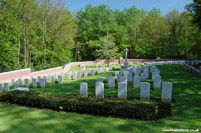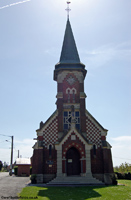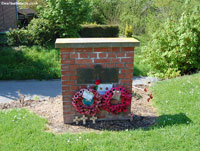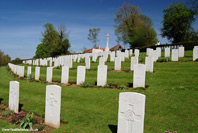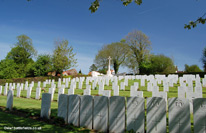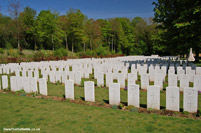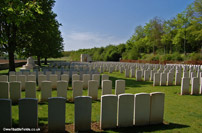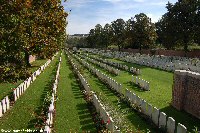The Ancre Valley
The World War One Battlefields site is undergoing a major update, with pages being converted to a new, user-friendly mobile format. The updated pages can be found at Updated World War One Battlefields. Some pages such as this one amd the others in the left hand menu remain in the original format pending update. Much more content is available on the Updated World War One Battlefields site.
The Ancre is a river which runs through Albert and then south-east to eventually join the River Somme near Corbie. Further upstream, however, its course is to the north of Albert, and it runs by the villages of Beaucourt, Authuille and Aveluy. There are a number of Great War sites of interest in and between these villages, as well as a number nearby which, although not strictly in the Ancre Valley, I have included here for interest.
The Ancre gave its name to two of the final phases of the 1916 Battles of the Somme, designated as the Battle of the Ancre Heights and the Battle of the Ancre (both in November 1916). The latter on the 13th to 19th of November made gains to the north of the river and included the taking of Beaumont Hamel.
Travelling north from Albert on the D50, the first of the three villages mentioned above to be reached is Aveluy.
Aveluy
The village itself is not on the D50; it is a short distance off to the right on the D20. However, there is not a great deal to see within the village in relation to the Great War, although there is a war cemetery here: Aveluy Communal Cemetery Extension. In 1933, Vera Brittan (author of Testament of Youth) visited Aveluy and commented that it had been rebuilt with 'new red-brick houses, white mortar, bright blue painted railings'. The church can be seen at the end of the village street. Just to the east of the village across the River Ancre is one of many spots on the battlefields known as 'Crucifix Corner' (not to be confused with the Crucifix Corner near High Wood). This spot was described by George Coppard in his war memoirs, as he travelled towards the front on the afternoon of the 1st of July 1916: 'There was a terrific crowd of troops and vehicles at Crucifix Corner. The road forked there......the left fork led to Thiepval, la Boiselle and Ovillers. The right fork led to Fricourt and Contalmaison. We took the left fork, glad to get away from the congestion'. The spot was then by a large quarry, the remnants of which can still be seen today. The original crucifix was destroyed in the war, but a replacement made after the war still stands here.
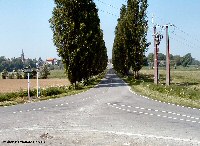
View from Crucifix Corner towards Aveluy
After I first set this website up I was contacted by Philip Watson, whose grandfather John Alan Watson served in the Royal Garrison Artillery with the 76th Siege Battery in the First World War. Usually known as Alan, Philip's grandfather kept a diary during the war and Philip has transcribed this and set up an excellent website where the entries can be read, as well as some more information on his grandfather both before and after the war (he served with the Home Guard during the Second World War and died in 1961). The website can be found at www.soar100.freeserve.co.uk, and is a mine of useful contemporary information.
Alan Watson returned to France after the war, and in 1929 took a photograph of the replacement crucifix at Crucifix Corner. This is shown below, along with a similar view taken by Philip (his grandson) when he visited the spot more than half a century later.
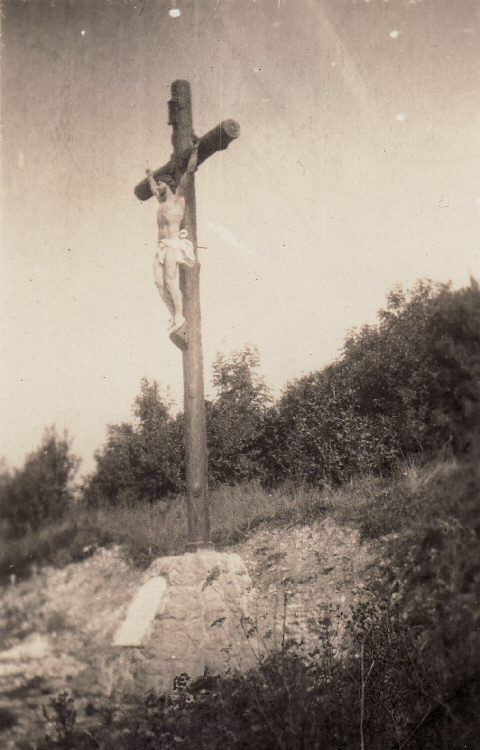
The crucufix at Crucifix Corner in 1929. Photo taken by John Alan Watson, used by kind permission of Philip Watson
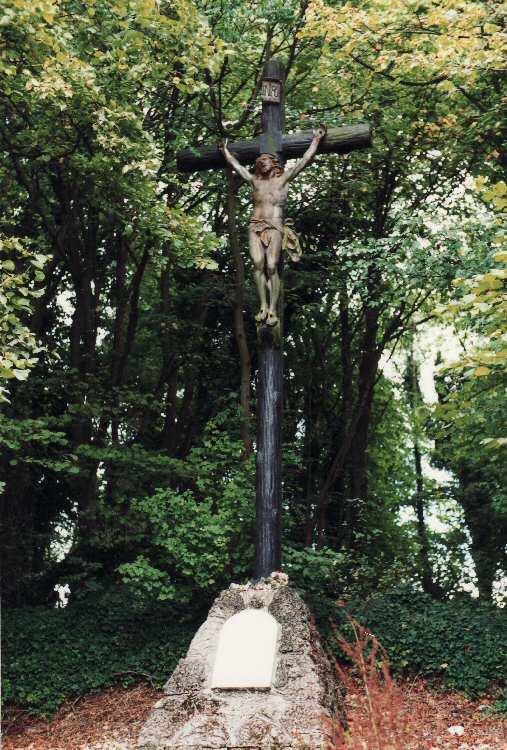
The crucufix at Crucifix Corner in 1993. Photo by Philip Watson
One of Alan Watson's cousins, Norman McMorrin, was also serving with the RGA (in this case with the 26th Siege Battery). He and Alan met up sometime in July 1916, but a few days later Norman was killed, probably somewhere very near here. Alan Watson wrote in his diary on the 28th of July 1916, "A chap out of 26th Siege Battery came and told me Norman had been killed. I cannot realise it - only a day or two since he was here and we were both hoping this push would end the war and we could get back home again". Of course the Somme push was not to end the war, but Norman McMorrin died aged 20 on the 26th of July 1916, and is buried not far away in Aveluy Communal Cemetery Extension. Philip has a picture of Alan and Norman together captioned 'Somewhere in France, April 1916'. These stories of the human tragedies behind the epic history exist throughout the war, but to see the faces of those who fought and died makes it more real for me. Many thanks to Philip for use of these pictures and please visit his website to read more.
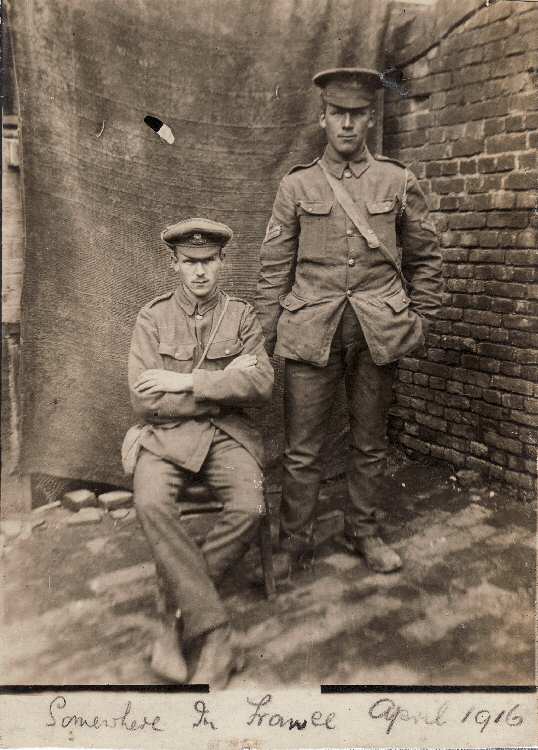
Norman McMorrin (left) and John Alan Watson 'Somewhere in France'. Photo used by kind permission of Philip Watson
Continuing further north on the D50, the road runs through Aveluy Wood, and this straight road is quiet and somewhat oppressive due to the thick woodland directly on either side of the road. At the beginning of the Battle of the Somme, the 32nd and 36th Divisions were based in the wood, with the latter's headquarters actually within the wood itself. Towards the northern end of the wood, on the right side as you travel north is Aveluy Wood Cemetery.
This cemetery is sometimes also known as Lancashire Dump (originally East Lancashire Dump) - a name that is given in brackets on the plan in the register, and the CWGC website records that the cemetery was in an area known as Lancashire Dump. From the entrance, steps lead down into the cemetery, flanked on both sides by low hedges. The cemetery is fan shaped, and the Cross of Sacrifice is located where the cemetery begins to widen out. The first burials here were made in June 1916, before the start of the Battle of the Somme. The early graves are in Plot 1, rows A B and C, which are at the rear left of the cemetery, and these burials are very irregular in layout and spacing.
The cemetery was used from then on until the Germans withdrew to the Hindenburg line in early 1917, and these graves make up the majority of the rest of Plot 1. It was used once more in September 1918 for the burials of men who had fallen in the area when the Germans took the wood during their major spring offensive that year. These 1918 graves make up row H of Plot 1. In 1923, more graves were concentrated from the surrounding areas and added to Plot 1 to make rows I-M. The two plots towards the front, in the narrower part of the cemetery, are of isolated graves brought in from Aveluy Wood and also of concentrations of graves from around the area after the Armistice. It is thus an interesting cemetery, with several distinct phases of use.
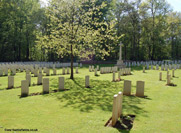
Early graves (in the foreground) at Aveluy Wood Cemetery
At the back of the cemetery is a stone bench, with special memorials to men known to be buried here on either side. Perhaps some of these account for the 'gaps' in rows A B and C of Plot 1, although there are several for men who died in early 1917. In total there are nearly 400 men buried or commemorated here, with nearly half being unidentified. One soldier with an interesting background who is buried here is Private William Danieloff Gorkoon, who was serving with the 51st Australian Infantry when he was killed on the 3rd of September 1916, during an attack on Mouquet Farm. He had enlisted only nine months before in Blackboy Hill, Western Australia, but was originally from Samara in Russia, where his father Danieloff still lived. William was a railway sleeper cutter by trade, and had previously served for two years with the Russian Field Artillery. He had arrived in Australia in October 1912, and was one of around a thousand Russians who served with the Australian Army during the First World War.
Gorkoon had a chequered military career; he only arrived in France in June 1916, and by the 20th of July he had already been docked pay on two occasions: five days pay for falling out without permission and 'telling a falsehood to an N.C.O', and 21 days for being late on parade and 'using obscene language to an N.C.O.'. His knowldege of English when he enlisted was described as 'very limited', but he obviously knew certain words well enough! At the end of August 1916 he was once more in trouble, and was found guilty at a Field General Court Martial of being absent without leave on the 5th of August. His defence was that he had had some drinks with friends and did not remember what happened after that. The sentence awarded was 9 months imprisonment with hard labour, although this was suspended. Just 13 days after the court martial he was reported missing in action, and at a Court of Enquiry in April 1917 he was officially listed as killed in action. A memorial cross was erected to him near to where he was believed to have been killed (about two miles east of this cemetery). The Court of Enquiry that certified him as killed in action considered statements from members of his unit who saw him killed. One, who had escaped after being made a prisoner of war said 'I saw him hit. Shrapnel got him all over'. Private W G Hunter added that Gorkoon had a moustache which he turned up at the ends, had a 'peculiar disposition' and although well read and very intelligent he was thought to be 'disappointed with life in some way or another'. He was killed during an intense artillery barrage near Mouquet Farm, along with his best pal, another Russian named Louis Pasvalsky (who had the nickname 'Charlie Chaplin').
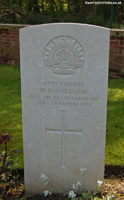
The grave of Private William Gorkoon: he travelled from
Russia to Australia then to France where he died
One is left wondering as to the story behind this man who travelled half way across the world from Russia to make a new life in Australia, then travelled back to Europe to fight in a war and ended up being killed shortly after a Court Martial and was buried in a small cemetery in France. We should never forget that there are stories behind all the many names you read on the headstones, and each life had its mysteries that we will never fathom now. As he was buried in Plot 1, Row M of this cemetery, Gorkoon's was one of the bodies transferred to this cemetery in 1923. In fact the identity disk recovered from his body when it was found was sent to his father (still in Russia) in November 1923, although it was described as 'considerably impaired through long exposure'. His body was found a little north of Mouquet Farm, tying in with where he was reported to have been killed. The body of his friend Louis Pasvalsky ('Charlie Chaplin') was never found or identified, and his name is commemorated on the Villers-Bretonneux Memorial to the Missing.
Authuille
Continuing north on the D50, after leaving Aveluy Wood there is a turn to the right which leads to the village of Authuille. There are several sites of interest in and around the village. In the centre of the village, on the left side of the main road (the D151) as you travel north, is the church.
To the left of the church door is a memorial tablet to three battalions of the Highland Light Infantry. This is in black marble, and commemorates the 15th (Glasgow Tramways), 16th (Boys Brigade) and 17th (Glasgow Commercial) Battalions. All three battalions were recruited in Glasgow in September 1914, and all in 1915 were assigned to the 97th Brigade, part of the 32nd Division. By the time of the Battle of the Somme, which this plaque commemorates, the 15th Battalion HLI had been transferred to the 14th Brigade (still within the 32nd Division).
The plaque commemorates the men of these battalions who 'fought and died near the village of Authuille' on the 1st of July 1916. On that day, the 16th and 17th Battalions were in the front lines just east of Authuille, and men of the 17th inched forward from their trenches at 7.23 a.m. to be as close as possible to the German lines, here including the formidable Leipzig Redoubt, when the British barrage lifted. This led to them achieving surprise, and they were able to storm the redoubt catching the Germans still in their dugouts. They pressed on, taking another important German trench, the Hindenburg Strasse, but were then forced back to the Leipzig Redoubt by a machine-gun firing from a position known as the Wunder Work, which was probably just a little to the south of where the Thiepval Memorial stands today. The battalion sustained 469 casualties.
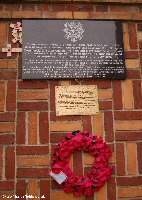
Memorial to the 15th, 16th & 17th Battalions
of the Highland Light Infantry
The 16th Battalion were not so successful even initially; the wire in front of the German lines they attacked (to the north of the Leipzig Redoubt, with the Wonder Work their first objective) was not cut, and although they too tried to approach the German lines just before the barrage lifted, the Germans here were ready and they were caught in No Mans Land by fire from the trenches and also from a strong-point in the ruins of Thiepval Chateau. They were relieved only at 3.30 a.m. on the morning of the 3rd of July, and moved back to Crucifix Corner (see above). Their casualties were 554.
The 14th Brigade were in reserve on the 1st of July, and although some troops did advance in support later in the day, the 15th HLI were not in action, although they suffered some casualties, probably from shellfire. However, on the 3rd of July they did take part in an attack, again near the Leipzig Salient. There was some confusion surrounding the attack, and very little artillery support. Two companies of the 15th HLI attacked at 6.15 a.m., and entered the German lines twice, but were forced out both times. Casualties for this attack were 285.
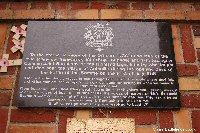
Close up of the Highland Light Infantry Memorial
Underneath the black tablet is a smaller brass plaque that is starting to look a little weathered; this repeats much of the information in French, and also explains that this memorial was unveiled on the 30th of June 1996.
Just a little further up the road from the church on the left hand side is the village Poilu memorial, and next to this is a brick built memorial to the Salford Pals. Again, this commemorates three battalions: the 15th, 16th and 19th Battalions of the Lancashire Fusiliers, also known as the 1st, 2nd and 3rd Salford Pals respectively.
All three battalions were formed by the MP Montague Barlow along with the Salford Brigade Committee, in late 1914 and early 1915, and like the HLI battalions described above were part of the 32nd Division. In fact, although all three battalions were initially with the 96th Bridage, one (the 19th Lancashire Fusiliers or 3rd Salford Pals) were also, like the 15th HLI, transferred to the 14th Brigade early in 1916.
The 1st Salford Pals attacked north of here, in front of Thiepval on the 1st of July 1916, and although a few men did reach the German lines they were captured or killed by the Germans and most of the men did not even get that far, but were cut up by machine-gun fire from Thiepval. They lost 470 men as casualties from the 624 who attacked. Men from 'B' and 'C' Companies of the 2nd Salford Pals were ordered up to support them, but were forced back, again by machine-gun fire, sustaining over 200 casualties. The 3rd Salford Pals suffered badly from machine gun fire as they moved up to the front on the 1st of July, and the remains of the battalion withdrew to Authuille at midnight.
The memorial is one of a number erected by the Western Front Association; in this case the Lancashire and Cheshire branch, and the brass plaque on the front adds that the Salford Pals held the trenches in Authuille from early 1916 and 'valiantly attacked the redoubts of Thiepval on 1st July 1916'. The numbers of casualties sustained by these battalions (each nominally around 1,000 men, although often a few hundred less at 'fighting strength') show how the appalling casualties the British suffered on the first day of the Somme mounted up.
Also in Authuille is Authuille Military Cemetery; in my opinion one of the most beautiful cemeteries in the Somme area. It is set on a slope up from the River Ancre itself, and probably because of this sheltered position was used by Field Ambulances from August 1915. Less than 10% of the 450 or so burials are unidentified.
As you enter the cemetery, the Cross of Sacrifice is in the corner at beside you at the top of the cemetery. Set against the hedge at the top of the cemetery are special memorials to 18 men known or believed to be buried here. The graves slope away down a steep hillside with the rows curving along the contours. The river is just below the cemetery, and cows graze in a field beside it. Perhaps the most pleasing aspect is to look back up the hillside from the bottom of the cemetery, as shown in the photos above. Here at the bottom is a row of 13 graves of men from the Dorset Regiment who all died on the 8th of May 1916. In Row A on the right side of cemetery when looking up from the bottom are a number of Indian graves from 1915.
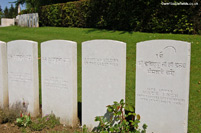
The graves of Indian soldiers in Authuille Military Cemetery
As always, some of the personal inscriptions at the base of the headstones make one pause for thought. On the grave of Second Lieutenant Michael R L Armstrong of the Royal Engineers, who died on the 22nd April 1916, are the simple words 'So Long'. For Lieutenant Norman Wilson of the 7th West Yorkshires (the Leeds Rifles) who died on the 14th of July 1916, the inscription reads 'Fell at Thiepval, reunion is my hope'. From the same regiment but this time the 1/5th Battalion, Arthur Naylor from Leeds was just 19 when he was killed in action on the 7th of August 1916. The inscription on his headstone reads 'His loving memory is more than words can tell. Father'.
Returning to the main road through the village (the D151), follow this south for about a quarter of a mile to find a cemetery on the left side, set about 300 yards back from the road. This is Blighty Valley Cemetery, and there is just enough space at the edge of the road to leave your car and walk up the track to the cemetery.
Just inside the cemetery and to the left are special memorials to five soldiers who died as prisoners of war. They were buried by the Germans in Becourt German Cemetery, but their graves could not be found when other bodies were concentrated (i.e. moved to other cemeteries). The group of special memorial stones stands behind a larger 'Duhallow block' giving this information.
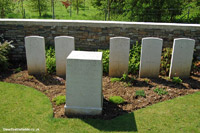
Special Memorials at Blighty Valley Cemetery to men who died as Prisoners of War
Half way down the cemetery on the left are three graves set at right angles to the others, and just beyond this on the left side are more special memorials all except one commemorating men known to be buried in the cemetery (the other is to a man believed to be buried here). The cemetery was started early in July 1916 and used until the following November. In 1916, a light railway marked on trenchmaps as the "Nab Valley Railway" ran up the valley here, and its tracks must have passed within a few yards of these early burials. By the Armistice the cemetery contained 212 graves, and Plot 1 containing these original graves is in the middle, with the headstones less evenly spaced than the others. After the Armistice, many more bodies were brought here, either from the battlefields or from small cemeteries to the east. Most of these concentrated graves were of men who died on the first day of the Somme, July the 1st 1916. The cemetery now contains 1,027 burials and commemorations, with 536 of the burials unidentified.
Returning north to Authuille, the turning left in the village and crossing the Ancre leads to the D50. Travelling north, this road runs by the railway line and in the valley of the Ancre. About a mile or so north from the turn to Authuille is a large cemetery on the left side of the road.
Ancre British Cemetery
This cemetery has at its core an original wartime cemetery, like many others in the area created after the German withdrawal to the Hindenberg line in early 1917. It was originally called 'Ancre River No.1 British Cemetery, V Corps Cemetery No.26', and contained 517 burials, mainly of men from the 36th and 63rd Divisions. The location of the cemetery is in the No Mans Land of summer 1916, and a feature known as 'Picturedrome' was locatd just across the road from here. The cemetery is set up above the road, with an imposing wall at the front and the Stone of Remembrance visible directly above the cemetery name. Steps to the left and right lead up to the cemetery, and there is also a grass track at the left which slopes up around the wall to the cemetery itself.
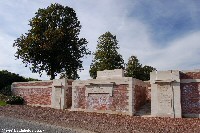
The entrance to Ancre British Cemetery
After the Armistice many isolated graves from the battlefields were brought here, and also bodies from a number of other cemeteries were moved here. These included the nearby 'Ancre River No.2 British Cemetery, V Corps Cemetery No.27' (which was only a few hundred metres east of here). Graves from a number of cemeteries given names associated with specific units were also moved here, such as the RND Cemetery between Beaumont-Hamel and Hamel, and the Sherwood Cemetery near it. Y Ravine Cemetery No. 2 was also concentrated here (this was originally 300 metres south-east of the Y Ravine Cemetery that can still be seen in the Newfoundland Memorial Park not far from here).
There are now over 2,500 soldiers buried or commemorated here, with less than half being identified.
Ancre British Cemetery runs quite some distance back from the road, with the Cross of Sacrifice located at the rear. There are many graves from the 63rd Royal Naval Division here. This Division had a particular association with the Battle of the Ancre, and their memorial can be seen not far away (covered later in this page). The Royal Naval Division was formed from Naval Reservists in 1914, and before the Somme had already fought in Gallipolli. It had remained under the auspices of the Navy, but in April 1916 it was officially transferred to the War Office and designated the 63rd (Royal Naval) Division.
Duhallow blocks (named after their first use in Duhallow Cemetery near Ypres) with inscriptions which describe the reasons for special memorials are located at the front right and left of the cemetery. The special memorials commemorate soldiers killed and buried in Green Dump and Beaucort Station Cemeteries whose graves were destroyed in later fighting.
Half way up in the middle of the cemetery are what appear to be two semicircular rows of graves backed by low hedges. In fact these are more special memorial 'headstones' to 43 soldiers known or believed to be buried in the cemetery. They include a number of Newfoundlanders such as Private James Atwill who died on the 1st of July 1916. Another special memorial is to Private Lionel Soper of the 1st Honourable Artillery Company, who died on the 13th of November 1916 aged 20. His 'headstone' has the inscription 'I die content'.
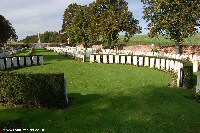
Special memorials at Ancre British Cemetery
At the rear of the cemetery is the large Cross of Sacrifice (this was made at different scales to match the size of the cemetery). Steps either side lead up to a lawned area with flower beds, from which there are impressive views of the cemetery itself as it slopes down to the road, and also up the slope ahead on the other side of the river to where the Ulster Tower can be seen. The height advantage of the German positions on the ridge can be appreciated.
There is an unusual layout in Row E of Plot 4, where two individual headstones can be seen set just behind the rest in a row, as shown below left. In Plot 8 row 8, red roses grow on both sides of the graves (below right).
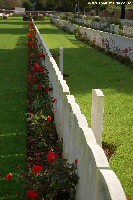
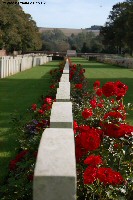
Grave layout and flowers at Ancre British Cemetery
A little further to the north, just within Beaucourt, on the left side of the road as it rises slightly is the Royal Naval Division Memorial. The memorial is in the form of a tall obelisk. There are bronze plaques on the front, the main one explaining that the memorial is to honour those men of the RND who fell at the Battle of the Ancre, during the final phase of the Somme Battles, on the 13th and 14th of November 1916.
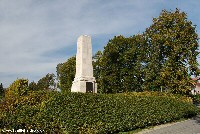
The Royal Naval Division Memorial
On the 13th of November 1916 the 1st and 2nd Royal Marine Battalions and Hawke, Drake and Hood Battalions among others were in action near here. Casualties were very heavy; of Howe Battalion it was reported that only one officer and around 20 men managed to reach the German third line, whilst Nelson Battalion suffered nearly 350 casualties during the battle. One populist view of the war is that senior officers were safe well behind the lines, but Lieutenant-Colonel Tetley commanding Drake Battalion was mortally wounded during this attack, and died two days later.
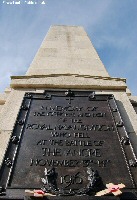
Main inscription on the Royal Naval Division Memorial
When the RND Memorial Committee was seeking to put a monument in place in 1921, Lord Rothermere offered to provide funding, as his son, Lieutentant the Honourable Vere Harmsworth had been killed in the Battle of the Ancre. He is buried in Ancre British Cemetery (see above). With the help of this funding, the memorial was unveiled on the 12th of November 1922. The position it stands on was in No Mans Land during the battle, and at the time of the unveiling the land still bore the scars. The unveiling ceremony was performed by General Sir Hubert Gough, along with Brigadier-General Arthur Asquith, and around 200 officers and men of the RND who had fought there were also present. The smaller plaque states that a record of the action commemorated is held at the Mairie in Beaucourt.
Mailly-Maillet
A little to the west of the Ancre valley, and further behind the lines in 1916, is the village of Mailly-Maillet. This is not in the Ancre valley, but is in the general area, and is of interest. The church of St. Peter that stands in the village survived the Great War largely intact. As described in Paul Reed's Walking the Somme this was because sandbags were used to protect the front of the church from shell-damage in 1916.
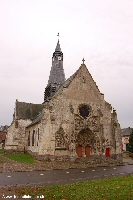
St. Peter's church, Mailly-Maillet
The church was built around 500 years ago, although now only the transept, porch and part of the belltower are of the original structure. It has been damaged on many occasions in its time, for example during 16th century wars, and by fires as well. However, one side of the church appears badly scarred perhaps by shrapnel damage, although this could date from earlier. Certainly the other side is in much better condition.
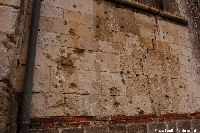
Scarred walls of the church at Mailly-Maillet
Because the war was 90 years ago, it is perhaps easy to forget that the soldiers who fought were often very young men, sometimes teenagers. Like many other young men before and since they carved their initials on surfaces, and several of these Great War graffiti survive in the stonework around the door of this old church. Some examples are shown below.
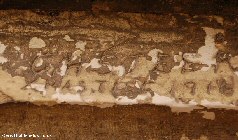
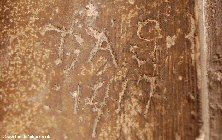
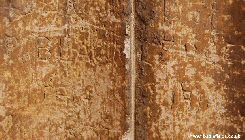
Great War 'graffiti' at Mailley-Maillet church
From left to right, the carvings appear to read 'G.H. Steer Xmastide 1916', 'T.A.S. 1917' and 'P. Blackledge P A H 1916'. There are other carvings which are more difficult to decipher, but it is fascinating to read these long ago carvings, made as soldiers idled time away, perhaps waiting to go up the line. The CWGC online records do not record a G H Steer or a P Blackledge killed during the war, so these at least were two of the lucky ones who survived.
Sources & Acknowledgements
Commonwealth War Graves Commission website
George Coppard: With A Machine-gun to Cambrai
Gerald Gliddon: Somme 1916
Great War Forum
Major & Mrs. Holt: Battlefield Guide to the Somme
Long Long trail website
Russian Anzacs website
Chris McCarthy: The Somme - the day by day account
Martin & Mary Middlebrook: Somme Battlefields
National Archives of Australia
Paul Reed: Walking the Somme
Times online archives
Philip Watson for information provided and use of photographs
Ray Westlake: British Battalions on the Somme

